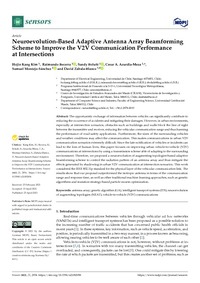Mostrar el registro sencillo de la publicación
Neuroevolution-based adaptive antenna array beamforming scheme to improve the V2V communication performance at intersections
| dc.contributor.author | Kang Kim, Hojin | |
| dc.contributor.author | Becerra, Raimundo | |
| dc.contributor.author | Bolufé, Sandy | |
| dc.contributor.author | Azurdia-Meza, Cesar A. | |
| dc.contributor.author | Montejo-Sánchez, Samuel | |
| dc.contributor.author | Zabala-Blanco, David | |
| dc.date.accessioned | 2021-12-30T14:52:48Z | |
| dc.date.available | 2021-12-30T14:52:48Z | |
| dc.date.issued | 2021 | |
| dc.identifier.uri | http://repositorio.ucm.cl/handle/ucm/3684 | |
| dc.description.abstract | The opportunistic exchange of information between vehicles can significantly contribute to reducing the occurrence of accidents and mitigating their damages. However, in urban environments, especially at intersection scenarios, obstacles such as buildings and walls block the line of sight between the transmitter and receiver, reducing the vehicular communication range and thus harming the performance of road safety applications. Furthermore, the sizes of the surrounding vehicles and weather conditions may affect the communication. This makes communications in urban V2V communication scenarios extremely difficult. Since the late notification of vehicles or incidents can lead to the loss of human lives, this paper focuses on improving urban vehicle-to-vehicle (V2V) communications at intersections by using a transmission scheme able of adapting to the surrounding environment. Therefore, we proposed a neuroevolution of augmenting topologies-based adaptive beamforming scheme to control the radiation pattern of an antenna array and thus mitigate the effects generated by shadowing in urban V2V communication at intersection scenarios. This work considered the IEEE 802.11p standard for the physical layer of the vehicular communication link. The results show that our proposal outperformed the isotropic antenna in terms of the communication range and response time, as well as other traditional machine learning approaches, such as genetic algorithms and mutation strategy-based particle swarm optimization. | es_CL |
| dc.language.iso | en | es_CL |
| dc.rights | Atribución-NoComercial-SinDerivadas 3.0 Chile | * |
| dc.rights.uri | http://creativecommons.org/licenses/by-nc-nd/3.0/cl/ | * |
| dc.source | Sensors, 21(9), 2956 | es_CL |
| dc.subject | Antenna array | es_CL |
| dc.subject | Genetic algorithm | es_CL |
| dc.subject | Intelligent transport systems | es_CL |
| dc.subject | Neuroevolution of augmenting topologies | es_CL |
| dc.title | Neuroevolution-based adaptive antenna array beamforming scheme to improve the V2V communication performance at intersections | es_CL |
| dc.type | Article | es_CL |
| dc.ucm.facultad | Facultad de Ciencias de la Ingeniería | es_CL |
| dc.ucm.indexacion | Scopus | es_CL |
| dc.ucm.indexacion | Isi | es_CL |
| dc.ucm.uri | www.mdpi.com/1424-8220/21/9/2956 | es_CL |
| dc.ucm.doi | doi.org/10.3390/s21092956 | es_CL |



